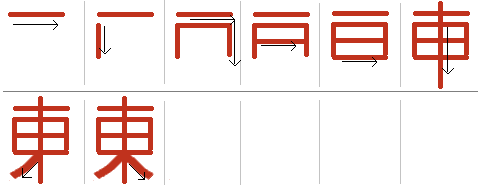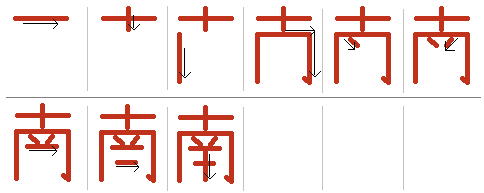You can practice Hanja by downloading a Hanja list for free and uploading to our app! Check our Hanja Lists and many of our other free tailored lists here. Check out how it looks on our app in this YouTube video.
—
In this lesson, you will learn how to represent the four cardinal directions in Hanja.
——————————————————————————————————
.
東 = 동 = East (동대문)
(Korean name: 동녘 동)
This character is great because many stroke order rules come into play when drawing it. Notice that the first stroke is the line at the top, moving left to right (Rule 1). Then, you need to draw the box in the middle, but remember that you should start with the left side, and then top and right sides before enclosing it (Rule 5). However, before enclosing it, you must draw the contents inside it (Rule 7). Following that, you should draw the major intersecting line (Rule 6). Finally, you must draw the two diagonal strokes – starting with the stroke moving towards the bottom right (Rule 3).
You will see this character and the others below all over Korea, as the names of many places are named using these cardinal directions. When these names are translated to English, they usually just take on the English pronunciation of the respective Korean name. Therefore, a Korean learner of Hanja might not be aware of the actual meaning that a location might possess.
For example, the neighborhood “동대문” is translated to “Dongdaemun” in English. While Korean people know the meaning of “Dongdaemun,” English speakers (even those learning Korean) might not know. However, by knowing the Hanja characters that represent this name, we can understand what the name represents. The Hanja equivalent of “동대문”is “東大門.” With the knowledge that you have of these characters now, you should know that “동대문” actually means “Big east gate.” Many other places use these cardinal directions in their name.
 Common Words using this Character:
Common Words using this Character:
東양 = the “East” (the orient)
中東 = the Middle East
東해 = the East Sea
東아시아 = East Asia
東大門 = “Big East Gate.” Dongdaemun (area and monument in Seoul)
——————————————————————————————————
.
西 = 서 = West
(Korean name: 서녘 서)
Much like 東, 西 (and the other directions you will learn in this lesson) is used throughout Korea as the names of various locations.
 Common Words using this Character:
Common Words using this Character:
西大門 = Seodaemun (area and monument in Seoul)
西양 = the “West” (North America/Europe)
東西 = east and west
西해 = the West Sea
 ——————————————————————————————————
——————————————————————————————————
.
北 = 북 = North
(Korean name: 북녘 북)
As with the other characters, 北 is used throughout Korea on various names of places.
 Common Words using this Character:
Common Words using this Character:
탈北자 = A North Korean defector
北한山 = A mountain range in the North of South Korea 北한 = North Korea
北극 = the North Pole
——————————————————————————————————
.
南 = 남 = South
(Korean name: 남녘 남)
 Common Words using this Character:
Common Words using this Character:
南大門 = Namdaemun (area, famous market and monument in Seoul)
강南 = Gangnam area (South of the river) 오빤 강南 스타일!
南北한 = North and South Korea/The Koreas
南극 = Antarctica
——————————————————————————————————
.I normally introduce 5 new characters per lesson, but I always try to introduce them in groups of a similar theme. I couldn’t think of a fifth character that you absolutely must know at this point that relates to the four cardinal directions, so I am ending this lesson here.
Okay, I got it! Take me to the next lesson! Or,
Click here for a PDF copy of all our Hanja lessons.

